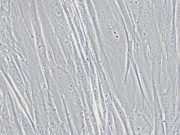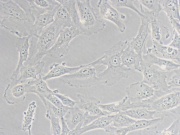Mammalian (basically human) cells in culture
From DNA Repair Lab
| Revision as of 14:11, 31 May 2007 Kmlima (Talk | contribs) ← Previous diff |
Current revision Kmlima (Talk | contribs) |
||
| Line 1: | Line 1: | ||
| - | '''Animal cell culture''' is a process by which animal cells are grown under controlled conditions, typically 37ºC and a humidified 5% CO2 atmosphere. It became a routine laboratory technique in the 1950s, and nowadays it is possible to isolate cells from many different tissues and in several ways. Cell cultures that are isolated directly from an organism are known as ''primary cells'', and frequently have limited lifespan. Because these cells undergo replicative senescence after a certain number of populations doubling, many researches are developed by using ''immortalized cell lines'', which are characterized by acquiring the ability to proliferate indefinitely, usually reached by the transduction of genes or viruses that lead to the deregulation of cell cycle. | + | [[Image:primária.jpg|thumb|Primary human skin fibroblasts (Magnification: 400X)]] |
| - | In '''DNA repair lab''', most of research works involving cell cultures for DNA repair studies employs primary or immortalized fibroblasts derived from skin of normal and XP patients. | + | |
| - | [[Image:Example1.jpg]] | + | [[Image:transformada.jpg|thumb|Immortalized human skin fibroblasts (Magnification: 400X)]] |
| + | |||
| + | |||
| + | '''Animal cell culture''' is a process by which animal cells are grown under controlled conditions, typically 37ºC and a humidified 5% CO<sub>2</sub> atmosphere. It became a routine laboratory technique in the 1950s, and nowadays it is possible to isolate cells from many different tissues and in several ways. Cell cultures that are isolated directly from an organism are known as ''primary cells'', and frequently have limited lifespan. Because these cells undergo replicative senescence after a certain number of populations doubling, many researches are developed by using ''immortalized cell lines'', which are characterized by acquiring the ability to proliferate indefinitely, usually reached by the transduction of genes or viruses that lead to the deregulation of cell cycle. | ||
| + | In the '''DNA repair group''', most of research works involving cell cultures for DNA repair studies employs primary or immortalized fibroblasts derived from skin of normal and XP patients. | ||
Current revision
Animal cell culture is a process by which animal cells are grown under controlled conditions, typically 37ºC and a humidified 5% CO2 atmosphere. It became a routine laboratory technique in the 1950s, and nowadays it is possible to isolate cells from many different tissues and in several ways. Cell cultures that are isolated directly from an organism are known as primary cells, and frequently have limited lifespan. Because these cells undergo replicative senescence after a certain number of populations doubling, many researches are developed by using immortalized cell lines, which are characterized by acquiring the ability to proliferate indefinitely, usually reached by the transduction of genes or viruses that lead to the deregulation of cell cycle.
In the DNA repair group, most of research works involving cell cultures for DNA repair studies employs primary or immortalized fibroblasts derived from skin of normal and XP patients.

